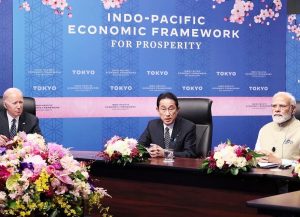Seven Southeast Asian nations are among the first nations to sign up to Washington’s long-awaited Indo-Pacific Economic Framework (IPEF). U.S. President Joe Biden launched the long-awaited economic component to the U.S. Indo-Pacific strategy in Tokyo yesterday, hailing it as a way of
From Southeast Asia, Brunei, Indonesia, Malaysia, Philippines, Singapore, Thailand, and Vietnam were among the 12 nations to sign up to the IPEF, along with New Zealand, Japan, South Korea, India, and Australia.
“We’re writing the new rules for the 21st-century economy,” Biden said in a speech marking the launch of IPEF, on the sidelines of the Quad Leaders’ Summit in Japan. “We’re going to help all of our country’s economies grow faster and fairer.”
The IPEF, which was first announced by Biden last October, has four main goals: harmonizing efforts to secure supply chains, expanding clean energy, fighting corruption and tax evasion, and paving the way for greater digital trade. According to an official U.S. statement, the IPEF envisions “a free, open, fair, inclusive, interconnected, resilient, secure, and prosperous Indo-Pacific region that has the potential to achieve sustainable and inclusive economic growth.” Negotiations with participating countries will now be overseen by Commerce Secretary Gina Raimondo and Katherine Tai, the U.S. trade representative, according to the New York Times.
The great rhetorical absence at the heart of Biden’s announcement was, of course, China, whose rapid economic integration with and growing assertiveness toward its neighbors prompted the formulation of the Indo-Pacific strategy in the first instance. If the Indo-Pacific strategy is another iteration of the “pivot” or “rebalance” initiated by President Barack Obama, the IPEF is effectively the Biden administration’s replacement for the Trans-Pacific Partnership (TPP), which was painstakingly negotiated Obama before his successor Donald Trump withdrew from f it on his first day in office.
With the launch at the start of the year of the Regional Comprehensive Economic Partnership (RCEP) officially went into force, linking 15 Asia-Pacific economies, including China and all of the members of the Association of Southeast Asian Nations (ASEAN), in the world’s largest trade bloc, the U.S. effectively found itself outside the two largest trade blocs in the Asia-Pacific.
But to call the IPEF itself a “bloc,” as the New York Times did in its headline yesterday, is to oversell its substance. “Framework” is very much the operative word in the title of the IPEF, which seeks to recreate the sweeping, rule-defining scope of a normal trade deal within the constraints of a U.S. domestic political mood that is deeply hostile toward multilateral trade agreements.
As such, the agreements will ask its signatories to adhere to a range of new rules, and adjust their economies accordingly, without granting them the increased market access that is usually at the heart of traditional trade deals. Last week, I cited an article by James Crabtree of Singapore’s International Institute for Strategic Studies, who argued that as a result of these limitations, the IPEF amounts to an “all-pain, no gain economic deal” for Southeast Asian countries. This also likely explains the generally skeptical tone of some Southeast Asian governments toward the IPEF when they met Biden for the U.S.-ASEAN Special Summit in Washington earlier this month.
The framework therefore requires a lot of filling in and elaboration before it can hope to achieve the lofty goals set out by Biden. The fragmentary nature of the enterprise was unintentionally hinted at in an official statement on the launch of the IPEF issued yesterday, which spoke of launching “collective discussions toward future negotiations” into the four pillars of the framework – what amounts to a commitment to discuss holding future discussions. (Hat tip to Evan Feigenbaum of the Carnegie Endowment for pointing this out on Twitter.) There’s a lot of work to be done, as Biden recognized yesterday. “This is going to be a haul. This is going to take some time,” he said.
Still, that so many Southeast Asian nations have signed up to IPEF points to the region’s hunger for greater U.S. economic engagement in the region, and their willingness to wait and see what transpires. It is unsurprising if one considers the findings of this year’s State of Asia survey report, which is carried out annually by Singapore’s ISEAS-Yusof Ishak Institute in order to gauge Southeast Asian elite opinion. The survey found that COVID-19 and the associated problems of unemployment and economic recession topped the list of Southeast Asian concerns in 2021, followed closely by climate change.
Despite its broad scope, the U.S. government therefore has a lot of work to do to convince Southeast Asian signatory governments that the agreement is motivated by a positive vision for the region, rather than a negative response to China’s growing power. “Inclusive economic cooperations will have positive impact in the long run,” said Indonesia’s Trade Minister Muhammad Lufti, who was quoted by the Times. “We do not wish to see IPEF merely be an instrument to contain other countries.”
While the involvement of so many Southeast Asian nations is a positive for the new U.S. strategy, signing up to the IPEF is basically cost-free. In the months to come, they are risking little by throwing their support behind the framework and seeing what it amounts to – and whether it lasts beyond the end of Biden’s tenure in the White House.

































